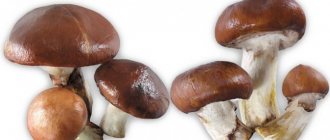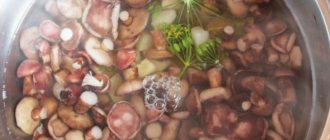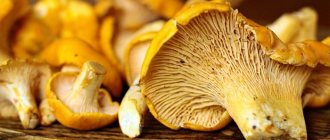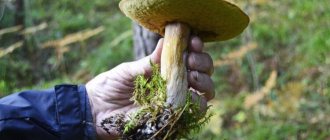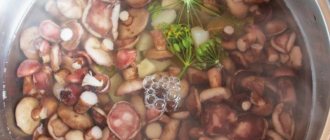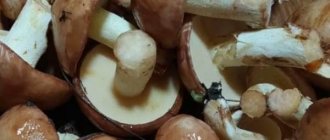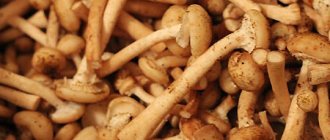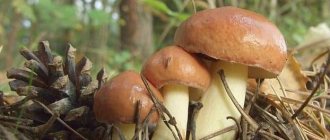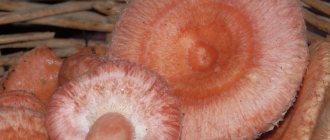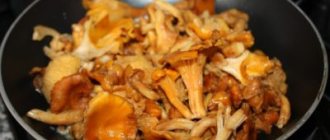Can you eat bruise mushrooms?
Bruise is an edible but rare mushroom. Edible but rare mushrooms - bruises, which were once highly valued by our ancestors, grow in all CIS countries. The bruise mushroom is very easy to recognize in forest spaces. A bruise has characteristic differences, among which the ability to acquire a blue tint is considered the most expressive.
Interesting materials:
What is Pikachu doing? What does a clerk do? What does OBS do? What does a turner do? What does a transponder do? What does an animal cell do? What is made from leather? What is made from carbon dioxide? What do you do in your first year of journalism? What do you do with khinkali tails?
What mushrooms turn purple when cooked?
There are several varieties of mushrooms that acquire a purple hue during or after cooking. First of all, these mushrooms include goats. The flesh of their fruiting bodies takes on an unusual burgundy or purple color during cooking. Boletuses also change color, but they turn purple-blue.
Important! Purple russula and boletus also turn bluish-lilac after cooking. This is due to the fact that their pulp contains a special enzyme called tyrosinase.
Kozlyaki
Kozlyak is a common mushroom from the Maslenkov family, also called reticulum. It received this name due to the tubular layer under the cap. Baby goat is an edible and completely safe mushroom that is approved for consumption.
Main features of the kid:
| Part of a mushroom | Features and description |
| hat | A baby goat's hat has downward-curved edges; as it matures, it begins to crack and the edges may begin to curl upward. The color of the cap can vary from ocher or yellow-brown to brown-red or dark brown. The size of the goat's cap ranges from 5 to 12 cm. |
| Leg | The thickness of the leg of the goat does not exceed 2 cm, the height is 9-10 cm. At the base, the leg has a dark, almost brown tint, closer to the cap it is a lighter color. The cut area of the leg quickly turns red when exposed to air. |
| Tubular layer | The tubes under the cap are yellow in color; as the mushroom matures, they become darker. The size of the tubes is 8-10 mm. The tubular layer is often tightly attached to the stalk and is difficult to separate from it. |
| Spore powder | Large size goat fungus spores. Spore powder is yellowish-olive in color, with a silver-gray tint. Externally, the spores have an angular, spindle-shaped shape. |
| Pulp | Mushroom pulp has a springy and elastic texture; even after prolonged heat treatment, the pulp retains its structure and does not become loose. Kozlyak has a pleasant mushroom smell. |
One of the main disadvantages of a kid is considered to be frequent infestation with worms.
In some cases, insects infect only the cap of the goat, and the leg remains intact. When collecting goat kids, you need to carefully check all parts of the kid for the presence of worms. Only young, small-sized fruiting bodies are consumed as food. Goats are often confused with boletus. The main similarity is that after fog or rain, the cap of both mushrooms becomes slippery, wet and slightly sticky.
But after 1-2 days, the surface of the goat’s cap dries out, while that of the butterdish remains moist. After heat treatment, the kid's flesh acquires a purple hue. This is a specific feature of this species, which does not indicate its toxicity or unsuitability for consumption. Goats are widely used in cooking - they can be dried, salted, pickled, and boiled.
This mushroom has good taste and nutritional qualities
Boletus
Boletuses are also capable of changing color during heat treatment. At the same time, the mushroom pulp of the boletus can acquire a blue, purple or lilac hue not only during cooking, but also immediately after cutting the stem. The purple tint of boletuses is associated with oxidative reactions that occur under the influence of oxygen on the substances contained in the mushroom pulp.
Important! Boletus contains variegatic acid, a pigment that gives the mushroom its characteristic color.
It is this coloring pigment, consisting of phenolic substances, that is oxidized to a blue tint under the influence of oxygen, as well as during cooking. A change in the color of the boletus does not mean that the boletus is unfit for consumption. It can be pickled, salted, stewed, boiled and baked, like any other mushrooms.
Boletuses are highly valued in cooking due to their taste and nutritional qualities.
Butter
Butterfly is a mushroom for which color change after cooking is not standard. Typically, boletus does not change its color and does not acquire lilac, purple or brown shades during heat treatment. The reasons why mushrooms turn purple can vary. Most often they are associated with errors or violations of heat treatment.
Darkening of the stem and cap of the butter dish may be due to cooking for too long. Plant proteins are destroyed under prolonged exposure to high temperatures, which leads to darkening of the mushroom body. The acquisition of purple or lilac shades may also be associated with the climatic characteristics of the region where butterweed grows, lighting conditions and soil composition.
These factors directly affect the chemical reactions in the tissues of the mushroom and the speed at which they occur during cooking. In the case of heat treatment of pickled or salted butter, a change in color occurs due to the addition of allspice or black pepper, coriander, mustard and other spices.
Butternuts darken under the influence of prolonged heat treatment
Are purple butterflies dangerous?
Many novice mushroom pickers are concerned that during cooking the collected boletus mushrooms turn purple, lilac or brown. You should not be afraid to eat such mushrooms. A change in color does not mean that the oil can is poisonous and does not pose any harm to human health. This is the result of chemical reactions occurring in the fruiting body under the influence of high water temperature.
How to cook boletus so that it does not darken
There are several simple rules for preparing boletus that will help preserve the attractive white hue of the mushroom pulp. To prevent mushrooms from changing color during heat treatment, you need to remember the basic rules:
How to cook goat mushroom
- Pour clean water over the purified boletus and bring to a boil, then boil for no more than 7-10 minutes and drain the water. Pour in new clean liquid with the addition of a small amount of salt and boil for 20-25 minutes.
- Butter should not be cooked for longer than 25-30 minutes, otherwise it will turn dark. If the butter is to be used for frying, the boiling time should be reduced to 10-15 minutes.
- If frozen butter is used for cooking, they must be defrosted in advance and only then subjected to heat treatment.
- When cooking, you can add a teaspoon of citric acid to a pan of water. It will preserve the light shade of the mushroom pulp and prevent it from darkening.
- To prevent the butter from darkening, be sure to add a preservative – table vinegar, citric acid – when salting and marinating.
In order for the marinated butter to have an appetizing, attractive appearance, you can sprinkle them with freshly squeezed lemon juice before serving. It will preserve the white color of the pulp and give the mushrooms a pleasant, light sourness.
The purple tint of butterfish is not a sign of their toxicity
What mushrooms turn blue when cut and why?
Mushroom pickers are a special people.
They prefer the silence and solitude of forest paths to stormy and fun fishing or hunting. Although in terms of the ability to concentrate, concentrate and wait, these hobbies are quite equivalent, because it’s not for nothing that mushroom picking is called “silent hunting.” And when it comes to patience when ignorant people ask questions about this hobby, mushroom pickers are also masters. But what are they most often asked about? It turns out that the leader among questions about “silent hunting” is the following: “If mushrooms turn blue when cut, does that mean they are poisonous?”
Looking for an answer
Let's find out the detailed answer to this question. As it turns out, blue flesh is a sign of a wide variety of mushrooms. From ordinary boletus mushrooms to the deadly satanic mushroom. And this phenomenon is not at all evidence of the presence of toxins in the pulp. Why do mushrooms turn blue in this case? This occurs due to air entering the pulp at the moment of breaking. The substances contained in its tissues oxidize and, due to reaction with oxygen, acquire a blue tint. And, as it turned out, many representatives of the mushroom kingdom are susceptible to such color changes. Even very tasty and healthy.
Yes, very different! The leader in the azure color of the flesh is considered to be a mushroom with the self-explanatory name bruise. In appearance it is completely inconspicuous, has a grayish-brown cap with a diameter of about 15 centimeters. But if you press on its surface, it will quickly turn blue. The bruise is edible in dried and pickled form, although it can be found infrequently - it is listed in the Red Book.
Another rare type of blue mushroom is the chestnut mushroom. Externally, it is very similar to the boletus in the shape and size of the cap. Therefore, if the porcini mushroom you find turns blue when cut, you are mistaken, and it is a chestnut or perhaps a Polish mushroom. There are differences between them - if the first one turns blue when pressing on the leg or when the flesh is damaged quite slightly, then the Polish one is painted with a bright blue pigment. In addition to them, two types of boletus also paint their legs with azure: the reddish boletus and the Frost boletus.
Dangerous satanic mushrooms are often confused with white mushrooms. By the way, they also fit into the category we are listing. Satanic mushrooms turn blue when cut, but only slightly. And before that, when broken, they tend to turn pink first, like many other poisonous representatives of the Berendey kingdom.
But other names of mushrooms, well known to most, belong to completely edible and very tasty species. For example, boletus and aspen boletuses turn blue when cut. Some types of oak and moss mushrooms also have azure flesh.
Conclusion
Thus, we see that a wide variety of mushrooms turn blue when cut. However, it is worth noting that of the poisonous species, only the satanic species has this ability. Therefore, if you find a fungus in the forest with a bluish tint to the cap at the break or the stem, it is highly likely that you can eat it. And in order not to confuse it with a satanic mushroom, it is worth remembering that the poisonous one most often has a domed cap, but the spores are red or orange, as is the characteristic mesh on the stem.
Places of distribution of purple mushrooms in the Moscow region
The Moscow region is an excellent place for “quiet hunting”. Among all the purple specimens in this area, the rowed ones are most often found. The best places for collecting are deciduous and mixed forests near any direction of the Moscow railway:
- Kursk;
- Kyiv;
- Leningradskoe;
- Yaroslavskoe;
- Gorkovskoe.
For other species you can go to the following directions:
- Serpukhov;
- Sobolevo;
- Kostrovo;
- Yaroslavskoe and Novorizhskoe highways;
- Khoroshilovo.
Advice!
You should look for mushrooms not only near deciduous and coniferous trees, with which the fruits can form mycorrhiza, but also on rotting fallen leaves and wood. On a litter of leaves and pine needles you can find entire glades of mushrooms, which are rarely found alone.
List of the most dangerous mushrooms in the world
Poisoning with these mushrooms can lead to all sorts of paralysis, edema, and kidney failure. If even a small dose is ingested, death is possible. Top 10 poisonous mushrooms in the world:
- Bloody tooth;
- Panther fly agaric;
- Death cap;
- The fly agaric is smelly;
- Spring fly agaric;
- The most beautiful cobweb;
- Galerina bordered;
- Patouillard fiber;
- Entoloma is poisonous;
- The talker is reddish.
How to determine whether a mushroom is false when cooked?
Here are some examples:
- When cooking, you can put the onion in the pan; if it changes color (becomes bluish or purple), then there are inedible specimens in your basket.
- When cooking, put any silver item into the pan; if it has darkened, the mushrooms are poisonous.
- There is an opinion that a vinegar-salt solution can neutralize the dangerous effects of false mushrooms if they are boiled in it.
- There is also a way to identify poisonous mushrooms using milk; if the milk curdles, the product is not suitable for consumption.
We remind you that all these options are unreliable ! You shouldn’t rely on them alone, because milk can curdle due to interaction with all kinds of enzymes, and a vinegar solution will never neutralize, for example, a toadstool.
Mushroom recipes: fresh butter soup
It is not necessary to boil the mushrooms before freezing; you can fry and freeze them fresh (the skin under and above the cap must be removed), but the boiled ones produce compact briquettes that are convenient to store in the freezer. And from the water in which the mushrooms were boiled, you can make a delicious boletus soup.
To prepare it, take boletus, potatoes, carrots, fresh herbs, onions, vegetable oil, and salt to taste. Peeled, prepared fruits need to be filled with water, boiled after boiling for a few minutes, then strain through a colander. Next, add new water, add salt, and cook for about 20 minutes, skimming the foam from the surface.
Place peeled, washed, chopped potatoes into the mushroom broth, boil, add herbs and spices, and simmer for 10-15 minutes. Place the fried boletus and vegetables into the broth and cook the mushroom soup until the potatoes are fully cooked, then turn off the heat. Cover the finished fresh butter soup with a lid and let it brew for a few minutes. Serve with sour cream and fresh bread.
Late oiler (real, ordinary, yellow)
Late oiler (Suillus luteus) is also called true, ordinary, yellow. In Central Russian forests this is the most common species. The name of the mushroom can be misleading, since late oiler does not appear in late autumn, but from June to October. True, the time of mass collection actually occurs in the fall (in some years even in November). Late oiler is a mushroom of pine forests. It can also be found in places where, in addition to pines, there are other coniferous trees.
Late butterwort is very productive, it grows in large groups. This mushroom is prepared fresh (fried, boiled, stewed), dried, salted and pickled.
Hat. The shape of the mucous cap (up to 12 cm in diameter) in young fungi is cushion-convex and hemispherical. In adults it is wide-conical. Its edges are down. The surface color of the cap is chestnut brown, red-brown or dark brown. The tubular layer is golden yellow or lemon yellow in color. Old mushrooms develop an olive tint.
Cap flesh. The color of the thick pulp is white or yellowish. It has a pleasant smell and a slightly sour taste.
Leg. The height of the solid cylindrical stem of the late butterdish is up to 10 cm, thickness - up to 2 (3) cm. In adult mushrooms it has a white or grayish-violet ring. Above it the color of the leg is white, below it is brownish.
We invite you to familiarize yourself with the Syngonium flower - types and varieties, how it blooms
Why butter?
This mushroom received its name because of the peculiar coating on the top layer of the cap, which has a sort of oily consistency. Also, the pulp, which has a soft yellow tint, resembles the color of butter. Why else was the butterdish mushroom called that way?
Interesting materials:
How to set millimeters in Sketchup? How to reinstall safari? How to certify a document in the prescribed manner? What form of government was established in Holland at the end of the 16th century? What is the minimum speed limit on the motorway? What is the normal length of the working week established by the Labor Code of the Russian Federation? What numbering is established for seasonal fast trains in long-distance and local traffic? What is the test frequency for dielectric gloves? What transitions can be set between slides? What programs should be installed on a laptop?
What to do in case of poisoning?
What to do if such a situation does occur? Let's look at what actions should be taken in case of mushroom poisoning . It is necessary to provide first aid in case of intoxication of the body.
There are several simple rules that, if followed, will help alleviate the patient’s condition:
- Call an ambulance immediately! When the first signs of poisoning appear, do not try to cope with the symptoms yourself. This can have very serious consequences;
- Provide the patient with pastel mode;
- It is necessary to drink water in large quantities; gastric lavage helps to eliminate toxins as quickly as possible;
- Activated carbon absorbs harmful substances and alleviates the patient's condition.
Thus, you can never know for sure whether the most dangerous mushrooms ended up in your basket or not. Even the most experienced mushroom pickers may not notice this. When going into the forest, you need to be as attentive and prepared as possible. And without hesitation, leave a dubious mushroom without attention.
Video about 5 deadly mushrooms in central Russia
In this video, Leonid Varlamov will tell you what mushrooms you should be wary of in the forests of central Russia, and how to avoid getting poisoned by them:
Few people know how to identify poisonous mushrooms when cooking.
In addition, few people know that they cannot be 100% classified as plants, since they contain signs of the animal world too. There are about 1.5 million species, subspecies and varieties of mushrooms in nature. This figure is a bit approximate, since scientists and avid mushroom pickers are discovering more and more new specimens. Science does not have an exact number of edible and poisonous mushrooms. It is believed that their percentage is 50/50, that is, they are equally divided.
Poisonous mushrooms can also be identified at the cooking stage.
This product is a common and favorite dish of many. In some national cuisines this product occupies a special, privileged place. Mushrooms can be pickled, salted, dried, served fried or boiled. There are a lot of recipes with this delicacy. Food with them acquires an extraordinary, unforgettable taste, and dishes decorated with this dish are a delight to the eye on any holiday table.
How to cook butter without turning brown
It is recommended to boil the product before any further use:
- before frying;
- freezing;
- slicing for salads;
- for soup.
To prevent the butter from darkening during cooking, there are several tips for the housewife:
- Mushroom raw materials should be kept in boiling water for no more than 30 minutes.
- Before frying, boiling time should be reduced to 15 minutes.
- It is important to first defrost the frozen preparation, and then cook it in the same way as fresh mushrooms.
- Before freezing, the butter must be boiled a little, dried, and put into bags. It is permissible to harvest raw fruits.
- When preparing soup, the first water must be drained, and the base of the dish will be the following broth. Boiling time should not exceed 30 minutes.
- When cooking, add 1 tsp. citric acid.
- It is recommended to simmer butter in a slow cooker for about 40 minutes.
There is no need to worry if the butter mushrooms turn purple after cooking: all the taste characteristics of the mushrooms will remain unchanged, and the dish will turn out just as appetizing as usual.
What poisonous specimens can be found in our country?
Here is a partial list of them:
- Death cap. Perhaps one of the most famous and most poisonous mushrooms in the world. Toadstool is dangerous because of its similarity to champignon, because even after heat treatment, a small piece of toadstool can kill an adult.
- Fly agaric and its subspecies (red, stinking). It would seem that the fly agaric, known to everyone since childhood, cannot be confused with anything, but it has many species, and some of them can easily be mistaken for edible.
- False honey fungus is sulfur-yellow. It is not difficult to guess from the name that this species masquerades as its edible fellow honey mushroom. False fungus grows almost all over the globe, and it will be extremely difficult for a non-professional to recognize it.
- Cobweb. He's very good-looking. The correct shape of the cap and a beautiful, even color can attract attention, but only an inexperienced mushroom picker will cut it off, because it has no non-poisonous counterparts.
- Red champignon. An inedible type of champignon, it can be distinguished by its unpleasant smell and reddish color of the flesh. Its use will not lead to death, but poisoning for several days is guaranteed.
- False boletus or gall mushroom. Quite often found in Russia. It is incredibly similar to its edible counterpart and it is sometimes impossible to distinguish them by appearance. But you will immediately understand that you made a mistake with your choice, because... False boletus tastes very bitter.
How to distinguish an edible mushroom from a false one?
Unfortunately, there are no exact criteria for such selection , so there is always a danger. Here we can give only a few tips that can protect you from making the wrong choice:
- As a rule, false specimens that have doubles grow in the wrong place (i.e. boletus, boletus do not grow under their own tree, honey mushrooms grow on the ground, etc.)
- Most inedible species, despite their attractive appearance, have a strong, repulsive odor.
- Each mushroom individually must be carefully examined and if there is the slightest doubt, do not collect it under any circumstances.
- If you are new to this business, consult with experienced mushroom pickers, or better yet, watch the process.
- When you decide to go on a hike on your own, don’t be lazy and prepare from a theoretical point of view. Study the relevant literature, look at thematic websites.
Misconceptions about recognizing poisonous mushrooms
There is no special sign or method by which one can distinguish a poisonous mushroom from an edible one! The “recipes” known in practice for recognizing and neutralizing poisonous mushrooms are erroneous and can lead to severe and even fatal poisoning. Let's look at the most common of them: 1. “Insect larvae (“worms”) and slugs do not eat poisonous mushrooms.” This is an erroneous and especially dangerous opinion, because highly poisonous mushrooms are also affected, which cannot be said, for example, about such a good edible mushroom as the yellow chanterelle. 2. “Onion or garlic heads turn brown if they are cooked with mushrooms, among which there is at least one poisonous mushroom.” In fact, both poisonous and edible mushrooms can turn onions and garlic brown if they contain the enzyme tyrosinase, which is found in many types of mushrooms. If there is no tyrosinase, browning will not occur, and the mushroom may be poisonous. 3. “If a silver spoon or coin placed in a pan while cooking mushrooms turns dark, this means that there are poisonous mushrooms among them.” You need to know that silver objects darken under the influence of certain groups of amino acids contained in different types of mushrooms. Consequently, the darkening of silver is affected only by the absence of these amino acids in the mushroom. 4. “All mushrooms with a pleasant taste are edible.” There are a number of poisonous mushrooms with a pleasant taste. For example, the deadly poisonous toadstool, the highly poisonous entoloma, the panther fly agaric and the red fly agaric are either pleasant to the taste or without much taste.
Delicious recipe! What delicious things can you eat?
5. “All mushrooms with pink plates are edible.” It is known that champignon, as a good edible mushroom, has pink plates in its mature state. But there are also poisonous mushrooms with pink plates, such as poisonous entoloma and yellow champignon.
6. “Poisonous mushrooms curdle milk.” Milk coagulation occurs from those types of mushrooms that contain a significant amount of acids or an enzyme such as pepsin. The rich content of these substances can be found in certain types of both poisonous and edible mushrooms. 7. “Poisonous mushrooms have an unpleasant odor.” Only some poisonous mushrooms have an unpleasant odor, for example, the spring fly agaric, the toadstool mushroom, and the yellow champignon. Others have a pleasant smell or no special smell. 8. “All mushrooms are not poisonous when young.” Poisonous mushrooms are dangerous at any age, including at a young age. 9. “Poisonous mushrooms grow only in forests, but they are not found in meadows, fields and other open places.” This opinion is also completely unfounded. In the Krasnodar Territory, cases of poisoning by mushrooms collected outside the forest are known. 10. If the flesh of a mushroom, when broken, turns blue, pink, red, or acquires a different color, then many mushroom pickers consider them poisonous. You need to know that a number of widespread edible mushrooms quickly change color when broken, and some even when pressed with a finger on the fruiting body, for example: bruise, hornbeam (ordinary and speckled), royal (luxurious) mushroom - turn blue, hornbeam turns purple-pink , then it gets dark.
Of the poisonous mushrooms, the flesh of the champignon turns yellow at the break, and the flesh of the satanic mushroom turns red. These species (especially the satanic mushroom) are common in some regions. Recently, there have been indications in the literature that the satanic mushroom is not poisonous, but this requires further verification. 11. There is a belief that poisonous mushrooms can be neutralized if they are boiled in salt water with vinegar. Indeed, some conditionally edible mushrooms are poisonous without boiling, but if they are boiled in salted water and the broth is drained, they are eaten. These include strings and other conditionally edible mushrooms. But it should be remembered that no treatment method neutralizes the deadly poisonous toadstool and some others. Thus, to avoid mushroom poisoning, you need to know poisonous mushrooms well by their morphological characteristics. This book will help you recognize them (identifier, list of poisonous mushrooms below, descriptions and pictures).
It is necessary to strictly adhere to the rule: do not use an unfamiliar mushroom for food, as it may be poisonous.
How to properly check mushrooms?
How then can you determine whether mushrooms are poisonous or edible? For beginners, it’s better to get a textbook and, when collecting, be sure to look and compare the picture with the type of mushroom that you found. Do not take fish that are suspicious or similar to edible based on only a few characteristics. Do not collect dried out or old mushrooms. If doubts creep in about the correctness of choosing a particular mushroom, then it is better not to put it in the basket. The harvested crop should be processed and sorted as quickly as possible. At home, in good lighting, you need to re-examine the collected mushrooms. All suspicious specimens should be thrown into the trash without hesitation.
To identify poisonous mushrooms, you need to add onions and garlic during cooking.
There are step-by-step instructions on how to identify poisonous mushrooms when cooking. It is worth noting that these are folk recipes that do not provide a 100% guarantee in recognizing poisonous mushrooms.
- Well-selected and familiar products should be rinsed in running cold water. Water will not wash away the poison, but if any of the mushrooms are in doubt or its appearance is unfamiliar, then it is better to get rid of it immediately.
- If the mushrooms were collected near megacities, highways, roadsides, then it is better to soak them for a while, let the water settle and drain it. And when cooking such specimens, the broth must be drained, changing the water several times to new one. This method will not help detect a poisonous mushroom; it will only clear the collection of dust and dirt.
- There is an interesting fact: when cooking mushrooms, you need to add a couple of heads of white onion and garlic. If the onion or garlic has changed its color to blue, brown or darkened, then most likely the collected mushrooms contain poisonous ones. The enzyme tyrosinase, which colors garlic and onions, is often found in poisonous mushrooms. But there are exceptions when edible mushrooms can contain this same enzyme, and some poisonous specimens, on the contrary, do not contain it. Vinegar can act as an indicator of this enzyme. When cooking, it is added to the water, and if it darkens, then it contains tyrosinase.
- Silver can be an indicator of poisonous mushrooms. It oxidizes and darkens due to amino acids that contain sulfur. That is, if you put a coin or a silver spoon into a decoction of poisonous mushrooms, it will darken. But scientists have proven that there are edible species that contain sulfur-containing amino acids, and, on the contrary, there are poisonous specimens that do not contain these acids at all. Therefore, this recipe for identifying toadstools is not 100% effective.
It turns out that there is no universal way to test poisonous mushrooms during cooking. Therefore, if you have the slightest doubt about the correct choice, it is better to throw away such a mushroom or not cut it at all.
Return to contents
